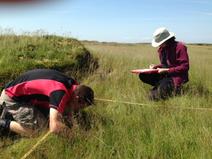Moors for the Future Partnership’s annual vegetation monitoring has come to an end for the year. Volunteers have collected data from 12 sites across Kinder and Bleaklow by monitoring the vegetation in 156 areas, known as quadrats.

The purpose of the vegetation monitoring, which starts in July after the bird breeding season ends, and finishes in autumn, is to discover what changes our conservation works are making to the landscape. By looking at what vegetation is living within each quadrat, we can find out if these changes are helping to create healthy blanket bogs.
The survey is carried out by randomly choosing a 2m x 2m square to survey in a particular area. The outline of a square, known as a quadrat, is placed onto the ground and wooden stakes are put in each corner. Once the species inside the quadrat have been recorded, the square is moved but the stakes stay in place so that another survey can be taken in the exact same place at a later date.The work has been carried out by 12 volunteers and two members of staff and took just over 277 volunteer hours to complete.
All the monitored sites have had conservation work done and are at different stages of returning to healthy blanket bog. Some of the sites have been monitored from being bare peat. The vegetation monitoring allows us to track the change in biodiversity, by tracking the increase in ‘indicator species’ (the species which are important for defining the healthiness of the habitat).
The data that has been collected will contribute to the data collected over the last ten years of vegetation monitoring. We can use this information to make sure that our conservation methods are successfully returning the uplands to healthy blanket bog.
Katherine Filby, from Severn Trent Water – a member of the Moors for the Future Partnership, said: “Having this data is really important so that the change that’s occurring from a landscape of bare peat to a landscape of active blanket bog, can be attributed to the conservation work done by the Partnership. The Partnership can then share this knowledge with our partners and other conservation organisations restoring degraded blanket bogs, so that the landscape benefits from the best conservation practice. It’s a big task and we couldn’t do it without the dedication of the fantastic volunteers.”
Julian Barber, one of several volunteers who carried out the vegetation monitoring, added: “It’s great when you have been living in the area for years and can see from the monitoring work how we are helping the landscape for the benefit of many including wildlife, visitors, local residents and organisations. It’s interesting walking on the moors and seeing the recovery of plant, animal and insect numbers when compared with the sterile bare peat of the 1970's.”
We always need an extra pair of hands so if you’re interested in volunteering with us, visit our website to find out how to get involved http://www.moorsforthefuture.org.uk/volunteering-opportunities